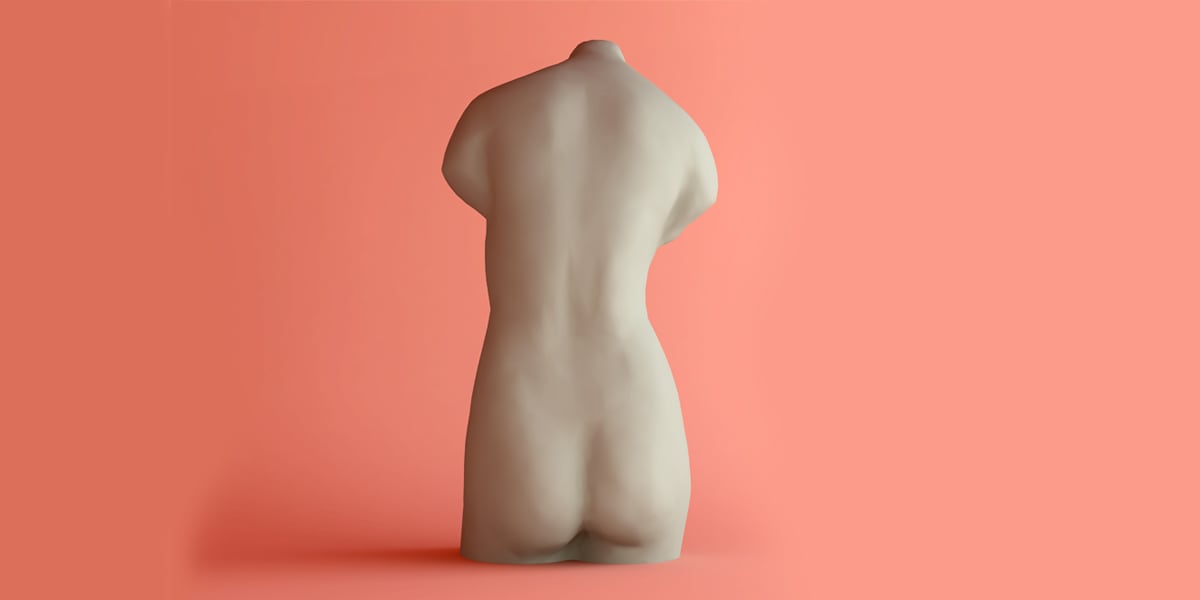Body neutrality: the growing alternative to body positivity

Celebrating diverse bodies is obviously good. Loving your own body? Good, in theory, but in practice, way easier said than done.
While it seems wonderful and empowering to be confident in your appearance, it’s also pretty unrealistic, especially given the loads of toxic beauty standards that we all still have to unpack and unlearn. Some days I love my body, and others...not so much. And in those moments, I not only feel ashamed about how I look, but an added layer of shame for caring what I look like in the first place — that tingle of guilt for being a “bad feminist.”
The growth of the rhetoric to always love your body is thanks to body positivity, a movement promoting loving your body no matter how it looks as a means of subverting the constant cultural messaging that suggests otherwise. At least, that’s how it started. Now, its message has been co-opted and morphed into an ideology that can exclude the very people it set out to embrace.

As body positivity has met more criticism, another option has arisen: body neutrality. Instead of focusing on loving how your body looks, body neutrality proposes accepting your body and focusing on its achievements rather than its appearance.
Here’s the low down on body neutrality and why it’s become an alternative to body positivity.
What is body neutrality?
Body neutrality means accepting your body for what it is without passing judgment (both positive and negative) about how it looks. Whereas body positivity draws empowerment from knowing your body is beautiful, body neutrality proposes that empowerment doesn’t stem from your appearance at all. Body neutrality is rooted in acknowledging and practicing gratitude for what our body does for us. For example, instead of thinking about the size of your thighs, think about what you need your thighs for and the things they allow you to do.
By aiming for self acceptance instead of self love, body neutrality recognizes the difficulty in loving everything about our bodies 100% of the time — because that just isn’t realistic. Body neutrality provides a middle ground between loving or hating you body, and doesn’t guilt you on the days you find it difficult to love any part of yourself.
Neutrality means indifference, but that doesn’t mean neglecting your body or your feelings about it, but rather renegotiating your relationship to them. You should not dissociate from your body, but rather take care of it so that it may continue to exist. Another way to think of body neutrality is as a form of body respect — you don’t have to love or even like your body, but you have to respect it. By taking the focus away from diet or weight, body neutrality allows a more holistic approach, one that can include both physical and mental health, as well as self care.

How is body positivity exclusionary?
Body positivity grew out of the fat acceptance movement in America in the 1960s, which was led by black and queer women raising awareness about anti-fat discrimination. It began as a movement to create a space for people whose bodies were rejected by society to come together, celebrate, and support each other. And while body positivity made some strides towards a more inclusive definition of beauty, as it grew in popularity, its focus shifted.
Body positivity began to single out plus size women who still fit within a very conventional beauty ideal: size 16 and under, with an hourglass figure, and usually white and able-bodied. When we see the term “body positivity,” we usually think of size, and even more specifically, women of larger size. What about people of color, people with disabilities and chronic illnesses, and trans and gender non-conforming people? Yes, plus size women face plenty of discrimination. But they are by no means the only ones. Yet they are often the only group body positivity is aimed at. The issue is not necessarily with body positivity as a concept, but the fact that mainstream body positivity still aligns with many conventional beauty standards, and therefore alienates the people it was meant to celebrate.
Body positivity also doesn’t address the real reasons why people with marginalized identities might not love their bodies. There is nothing inherently bad about being female, fat, black, or disabled. The reasons these bodies are devalued are socially constructed and systemically upheld — and they don’t change just because you love yourself. Body positivity puts the burden on people with nonconforming bodies to change how they feel about themselves, even though none of their material conditions have changed.

How is body positivity unrealistic?
Expecting people to switch from hating their bodies to unequivocally loving them is not only unreasonable, but it represents another type of perfectionism. Theoretically, body positivity embraces imperfections, but demanding that people love their imperfections is just expecting another impossible standard. Except this time it’s not about how you look, but how you think about how you look — which is arguably even harder to control. If we aim for complete happiness with our appearance, when we inevitably fall short it can leave us feeling like failures. The shame we are pressured not to feel about our bodies becomes shame for not consistently loving them.
Why is body neutrality a better alternative?
Body positivity is in line with the constant societal pressure to be happy all the time, and to suppress or resist “bad” emotions. But we all know that our relationships with our bodies are nonlinear and exist on a spectrum. For many of us, self acceptance is a much more achievable goal than self love. And while practicing self acceptance can eventually lead to practicing self love, for some of us neutrality is the goal itself. Just the possibility of a kind of peace with our bodies is important.
There are so many people for whom body positivity seems impossible because they feel betrayed by their bodies — people with eating disorders or body dysmorphia who can’t control or trust what they see in the mirror; trans and non-binary people struggling with dysphoria; people with disabilities or chronic illnesses who can’t depend on their own body to keep them healthy. For them, being body positive can be another struggle, while being neutral offers a relief.

How can I practice body neutrality?
Some mantras to practice:
This is my body.
I have the body I have and I accept it.
I won’t always love my body, but I will always respect it enough to take care of it.
I do not need to love everything about myself at all times in order to be kind to myself.
How I feel about myself has nothing to do with how I look.
My body allows me to experience the world in a way that brings me joy.
My body is an essential part of myself.




